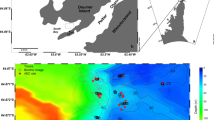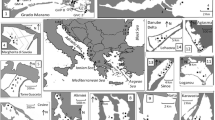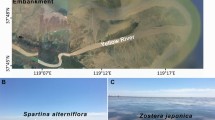Abstract
Carrying capacities of grazed habitats are typically expressed as numbers or biomass of animals per unit area; however, such parameters are appropriate only when the body size of animals is constant because consumption and other metabolic-rate based parameters such as respiration and production are proportional to body mass raised by a power of ≈0.75 rather than 0 or 1. Habitat carrying levels are therefore better expressed in the form of an index of total community consumption by summing the body masses of individual animals after they have been scaled using a biomass exponent of ≈0.75. A parameter scaled in this way,P 20, varied in a predictable manner when calculated for the mobile epifaunal assemblages associated with rope fibre habitats placed at marine and estuarine sites;P 20 showed no significant difference between 17 shallow, clear-water sites worldwide, but declined consistently when photosynthesis was reduced.P 20 also did not vary significantly when calculated for the mobile epifaunal communities associated with fourAmphibolis antarctica seagrass habitats in Australia (\(\bar x\) = 100 µg ·g−1 · day−1), and reached but did not significantly exceed a ceiling of ≈280 μg · g-1 · day-1 forSargassum plants. These results are consistent with the hypothesis that the production of shallow-water epifaunal communities of grazers is constrained by resource ceilings which can be quantified using metabolic-rate based indices. If this “production ceiling” hypothesis is correct then diffuse competition is generally more important than predation or environmental disturbance in restricting the growth of mobile epifaunal populations.
Similar content being viewed by others
References
Al-Ogilby SM, Knight-Jones EW (1977) Anti-fouling role of antibiotics produced by marine algae and bryozoans. Nature 265:728–729
Bell JD, Westoby M (1986) Abundance of macrofauna in dense seagrass is due to habitat preference, not predation. Oecologia 68:205–209
Brawley SH, Fei XG (1987) Studies of mesoherbivory in aquaria and in an unbarricaded mariculture farm on the Chinese coast. J Phycol 23:614–623
Cammen LM (1980) Ingestion rate: an empirical model for aquatic deposit feeders and detritivores. Oecologia 44:303–310
Edgar GJ (1983) The ecology of south-east Tasmanian phytal animal communities. II. Seasonal change in plant and animal populations. J Exp Mar Biol Ecol 70:159–179
Edgar GJ (1990a) The use of the size-structure of benthic macrofaunal communities to estimate faunal biomass and secondary production J Exp Mar Biol Ecol 137:195–214
Edgar GJ (1990b) The influence of plant structure on the species richness, biomass and secondary production of macrofaunal assemblages associated with Western Australian seagrass beds. J Exp Mar Biol Ecol 137:215–240
Edgar GJ (1990c) Population regulation, population dynamics and competition amongst mobile epifauna associated with seagrass. J Exp Mar Biol Ecol 144:205–234
Edgar GJ (1991a) Artificial algae as habitats for mobile epifauna: factors affecting colonization in a JapanaseSargassum bed. Hydrobiologia 226:111–118
Edgar GJ (1991b) Distribution patterns of mobile epifauna associated with rope fibre habitats within the Bathurst Harbour estuary, south-western Tasmania. Estuar Coast Shelf Sci 33:589–604
Edgar GJ, Aoki M (1993) Resource limitation and fish predation: their importance to mobile epifauna associated with JapaneseSargassum. Oecologia 95:122–133
Edgar GJ, Robertson AI (1992) The influence of seagrass structure on the distribution and abundance of mobile epifauna: pattern and process in a Western AustralianAmphibolis bed. J Exp Mar Biol Ecol 160:13–31
Fredette TJ, Diaz RJ (1986) Life history ofGammarus mucronatus Say (Amphipoda: Gammaridae) in warm temperate estuarine habitats, York River, Virginia. J Crust Biol 6:57–78
Gunnill FC (1983) Seasonal variations in the invertebrate faunas ofPelvetia fastigiata (Fucaceae): effects of plant size and distribution. Mar Biol 73:115–130
Heck KL, Orth RJ (1980) Seagrass habitats: the roles of structural complexity, competition and predation in structuring associated fish and macroinvertebrate assemblages. In: Kennedy VS (ed) Estuarine perspectives. Academic Press, New York, pp 449–464
Hornsey IS, Hide D (1974) The production of antimicrobial compounds by British marine algae. I. Antibiotic-producing marine algae. Brit J Phycol 9:353–361
Humphreys WF (1979) Production and respiration in animal populations. J Anim Ecol 48:427–453
Imada K, Kikuchi T (1984) Studies of the reproductive traits of three caprellids (Crustacea: Amphipoda) and their seasonal fluctuations in theSargassum bed. Publ Amakusa Mar Biol Lab 7:151–172
Jensen KT, Jensen JN (1985) The importance of some epibenthic predators on the density of juvenile benthic macrofauna in the Danish Wadden Sea. J Exp Mar Biol Ecol 113:9–21
Kikuchi T (1980) Faunal relationships in temperate seagrass beds. In: Phillips RC, McRoy CP (eds) Handbook of seagrass biology: an ecosystem perspective. Garland STPM, New York, pp 153–173
Klumpp DW, Howard RK, Pollard DA (1989) Trophodynamics and nutritional ecology of seagrass communities. In: Larkum AWD, McComb AJ, Shepherd SA (eds) Biology of seagrasses: a treatise on the biology of seagrasses with special reference to the Australian region. Elsevier, Amsterdam, pp 394–457
Kneib RT (1988) Testing for indirect effects of predation in an intertidal soft-bottom community. Ecology 69:1795–1805
Kneib RT (1992) Population dynamics of the tanaidHargeria rapax (Crustacea: Peracarida) in a tidal marsh. Mar Biol 113:437–445
Lavigne DM (1982) Similarity in energy budgets of animal populations. J Anim Ecol 51:195–206
Leber KM (1985) The influence of predatory decapods, refuge, and microhabitat selection on seagrass communities. Ecology 66:1951–1964
McNeill S, Lawton JH (1970) Annual production and respiration in animal communities. Nature 225:472–474
Marquet PA, Navarrete SA, Castilla JC (1990) Scaling population density to body size in rocky intertidal communities. Science 250:1125–1127
Moore PG (1977) Organization in simple communities: observations on the natural history ofHyale nilssoni (Amphipoda) in high littoral seaweeds. In: Keegan BF, Ceidigh PO, Boaden PJS (eds) Biology of benthic organisms. Pergamon, New York, pp 443–451
Morgan MD, Kitting CL (1984) Productivity and utilization of the seagrassHalodule wrightii and its attached epiphytes. Limnol Oceanogr 29:1066–1076
Nelson WG (1979) An analysis of structural pattern in an eelgrass (Zostera marina L.) amphipod community. J Exp Mar Biol Ecol 39:231–264
Nelson WG, Cairns KD, Virnstein RW (1982) Seasonality and spatial patterns of seagrass-associated amphipods of the Indian River Lagoon, Florida, Bull Mar Sci 32:121–129
Norton TA, Benson MR (1983) Ecological interactions between the brown seaweedSargassum muticum and its associated fauna. Mar Biol 75:169–177
Orth RJ, Van Montfrans J (1984) Epiphyte-seagrass relationships with an emphasis on the role of micrograzing: a review. Aquat Bot 18:43–69
Orth RJ, Heck KL, Van Montfrans J (1984) Faunal communities in seagrass beds: a review of the influence of plant structure and prey characteristics on predator-prey relationships. Estuaries 7A:339–350
Peters RH (1983) The ecological implications of body size. Cambridge University Press, Cambridge
Peters RH, Wassenberg K (1983) The effect of body size on animal abundance. Oecologia 60:89–96
Preston A, Moore PG (1990) Observations on the feeding habits of the commoner animals associated withCladophora algida (Huds.) Kütz. in rockpools. Glasgow Nat 21:523–535
Quast JC (1971) observations on the food of kelp fishes. In: North WJ (ed) Biology of kelp beds(Macrocystis pyrifera) in California. Beih Nova Hedwigia 32:541–579
Russo AR (1988) Detritus and epibiota on artificial substrata: the possible role of food in structuring Hawaiian epiphytal amphipod communities. Int Rev Ges Hydrobiol 73:319–325
Russo AR (1991) Do predatory fishes affect the structure of an epiphytal amphipod assemblage on a protected algal reef in Hawaii? Hydrobiologia 224:185–192
Ryland JS (1974) Observations on some epibionts of gulf-weedSargassum natans (L.) Meyen. J Exp Mar Biol Ecol 14:17–25
Sieburth JM (1968) The influence of algal antibiosis on the ecology of marine organisms. Adv Microbiol Sea 1:63–94
Sullivan MJ, Moncreiff CA (1990) Edaphic algae are an important component of salt marsh food webs: evidence from multiple stable isotope analyses. Mar Ecol Prog Ser 62:149–159
Virnstein RW, Curran MC (1986) Colonization of artificial seagrass versus time and distance from source. Mar Ecol Prog Ser 29:279–288
Wilson WH (1989) Predation and the mediation of intraspecific competition in an infaunal community in the Bay of Fundy. J Exp Mar Biol Ecol 132:221–245
Wiltse WI, Foreman KH, Teal JM, Valiela I (1984) Effects of predators and food resources on the macrobenthos of salt marsh creeks. J Mar Res 42:923–942
Young DK, Young MW (1978) Regulation of species densities of seagrass-associated macrobenthos: evidence from field experiments in the Indian River estuary, Florida. J Mar Res 36:569–593
Young DK, Buzas MA, Young MW (1976) Species densities of macrobenthos associated with seagrass: A field experimental study of predation. J Mar Res 34:577–592
Author information
Authors and Affiliations
Rights and permissions
About this article
Cite this article
Edgar, G.J. Measurement of the carrying capacity of benthic habitats using a metabolic-rate based index. Oecologia 95, 115–121 (1993). https://doi.org/10.1007/BF00649514
Received:
Accepted:
Issue Date:
DOI: https://doi.org/10.1007/BF00649514




